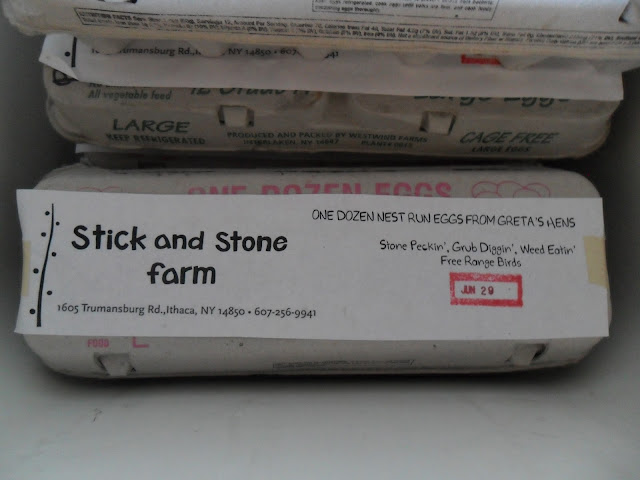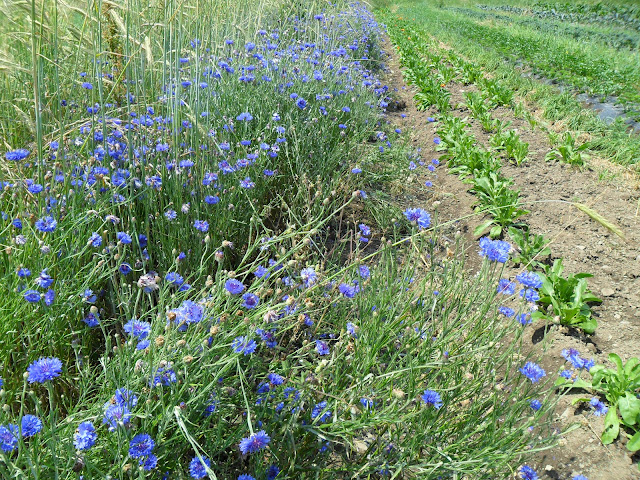I was able to visit Stick and Stone Farm which is about 10 minutes
drive from Sweet Land, just outside of Ithaca, NY. SSF is part of a collective of farms called
the Full Plate Collective. This is a really interesting approach to
CSA and combines the produce from multiple producers in the shares
offered to members. This approach supports smaller growers by giving
them an access to resources and a guaranteed market as well as allowing
growers to specialise in a particular crop (e.g. peppers) rather than
having to generalise..
Being able to start at a smaller scale also can help provide a stepping stone for an apprentice farmer who wants to farm for themselves. This is exactly what Mahra is able to do – she is growing a variety of sweet peppers for the collective this season on Remembrance Farm. This setup means Mahra can access land, resources and advice and in exchange for the labour she provides for this crop she will get a share of the income received from the distribution of these peppers.
Being able to start at a smaller scale also can help provide a stepping stone for an apprentice farmer who wants to farm for themselves. This is exactly what Mahra is able to do – she is growing a variety of sweet peppers for the collective this season on Remembrance Farm. This setup means Mahra can access land, resources and advice and in exchange for the labour she provides for this crop she will get a share of the income received from the distribution of these peppers.
FPC
offers summer shares and winter shares.The
produce is distributed through pick-up days, where the members come
to the farm to collect. These days are structured in a similar way
to Sweet Land Farm – one bag of whatever you choose from selected
crops, plus a selection of unlimited extras, as well as rotating
u-pick crops. As well as the direct pick-up, members can have their
share delivered (they don't get to choose the make-up of their share
in this instance), either to their home or to a group pick up point. The delivery logistics are handled
by Garden Gate and the price of this delivery varies (there is
financial incentive to have your share part of a single group
delivery, for example).
There
are three main farms involved in the collective - - as well as
smaller producers who offer bread shares (Wide Awake Bakery),
prepared food shares (Naked Carrot CSK), mushroom shares () and more.
Sara, who helps coordinate the collective also offers 'side-dishes' –
e.g. a dairy share which allows her to carefully curate a selection
of milk, yoghurt, butter etc. from local producers. I love this
'curation' approach to food. It certainly flies in the face of a
supermarket which offers 50 brands of everything or jumbled together
without any critique or coherance. And, like getting a recommended
reading or listening list from a friend, it's an entrée into another
person's tastes, values and experience.
We were only at the farm for a couple of hours but we were lucky enough to accompany Andrew on his chicken-run (members can also sign up for an egg share). We started out by throwing out a tub of fresh greens ('seconds' from the CSA distribution) to placate/distract the ladies while we privateered their eggs. Andrew was clearly passionate about the flock and knew what every chicken-custodian should – who's ok and who you should just leave on the nest. Apparently the hens were getting a little on the broody side and were becoming more pecky during the harvest. This was the first time I have helped collect more than a hundred eggs at a time and the scale was satisfying.
The hen setup seemed really good. There are three movable chook-mobiles (my dumb phrase, not theirs). Two are nesting/roosting places and one is an area where the hens can scratch and forage. This has a pretty deep litter floor and various forage materials are scattered in there to supplement the diet and to accommodate what chickens do best – scratch! Next to the area where the houses, feeders and waterers are is a sizeable row of triticale– a hybrid of rye wheat. The chickens can graze on this crop to supplement the mixed, ground feed provided. Hmm...I'm running out of computer patience, so for now, here is a montage of the chicken 'shanty town'.






























